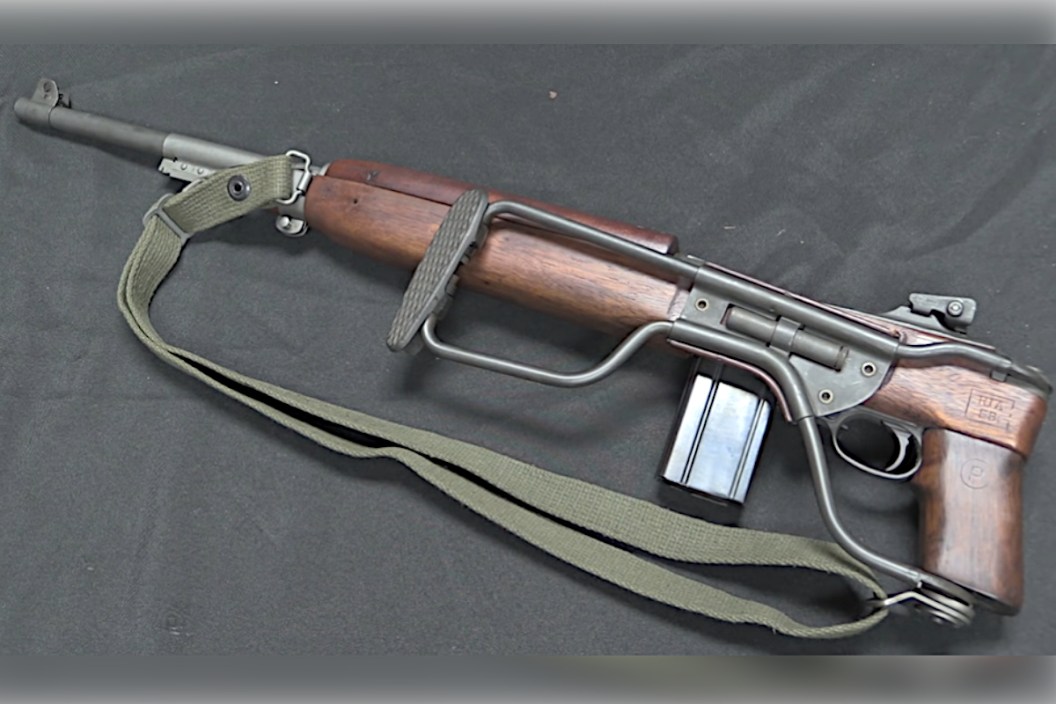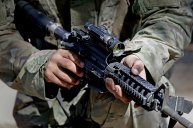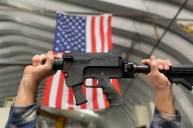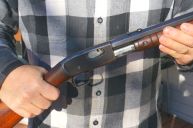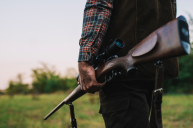The M1A1 Carbine was made famous by paratroopers.
When most people think of the American guns that helped win World War II, weapons like the semi-auto M1 Garand, and the M1918 BAR automatic rifle, or the bolt-action M1903 Springfield immediately spring to mind. Some people forget about the M1 Carbine, it was a firearm with a small profile that allowed the ability to carry extra ammunition into battle.
Today we're talking about a specific variant of the M1 Carbine and that is the model M1A1 Carbine. This was the paratrooper model, and it was built specifically for Airborne units since it was easier for troopers leaping out of airplanes to lug into combat.
This is the history of the M1A1 Paratrooper and why this gun is so sought-after by gun enthusiasts today.
A brief history of the M1 Carbine
Like most weapons of war, the M1 Carbine was born out of necessity. The M1 Garand was the standard issue military rifle in World War II. While the M1 is considered one of the greatest military rifles of all time, it has some drawbacks. Most notable is the weight. It weighed nearly 10 pounds and was extremely long, making carrying it into battle a real chore.
That weight becomes a problem for troops who were tasked with carrying extra support gear. Medical equipment, communications equipment, etc. There were also drivers, artillery teams and other specialties that didn't necessarily need a gun as large as the M1 making the stress of battle more difficult. The military was also concerned because many non-combative roles were often issued 1911 pistols and as any shooter knows, it is much more difficult to train people to be effective with a pistol than it is a rifle.
Initial requests for a light rifle that would require minimal training went largely ignored in 1938. It wasn't until around 1940 with tensions rising in Europe that the need for such a weapon became increasingly real with each passing day. The Ordnance Department Put out a request for such a gun with an extremely tight timeline. There was much trial and error with several manufacturers submitting prototype designs. However, in the end, none were up to the military's strict specifications. The military was already working with Winchester, the storied manufacturer had already developed the .30 caliber round from a modified .32 pistol cartridge that the M1 Carbine ended up using.
There's much more to the story than that, but to keep this short, Winchester already had another semi-automatic rifle design in the works called the M2 that was originally designed by John Browning's half-brother Jonathon Browning. This design was further refined by another famous figure David Marshall "Carbine" Williams, an ex-con who was convicted of murder, but had a penchant for firearms design and was hired by Winchester after leaving prison.
Marshall designed a new gas system for the M2, which was still chambered in .30-06 like the Garand at that point. Eventually, Winchester downsized the components of this rifle to fit the new .30 caliber round and submit it to the military's round of field testing. Despite this new downsized rifle being thrown together at the last second, it won out the military testing phase and becomes their new light rifle. This happened in 1941 and it was just in time because the U.S. was about to enter WWII.
M1A1 Paratrooper Carbine
In a twist that probably no one at Winchester or the military saw coming, the M1 Carbine ends up being the most mass-produced American gun of WWII. The factories ended up pumping out over six million of them over the course of the conflict. As is often standard with these types of weapons, variants were quickly developed for specific purposes. The M3 and M2 Carbines were given select-fire capabilities. And even though the M1 was light and compact, it was quickly realized that paratroopers jumping into combat behind enemy lines needed something even leaner and compact.
Inland Manufacturing, which was a division of General Motors stepped up with a solution in 1942. That was to design a new variant with a left side folding stock in lieu of the full wood stock that the standard models got. This brought the overall length of the gun down to just 25 inches when the stock was folded. The folding portion featured a folding cast buttplate and a cast cheekpad covered in leather.
The gun was also given a wooden pistol grip. However, as Forgotten Weapons notes in the video above, the M1A1 wasn't all that popular with many troops due to simple ergonomics. The full walnut stocks were always going to be more comfortable to use than a folding metal buttstock one. This firearm is a good reminder that military designs are usually never done with the comfort of the shooter in mind.
While most of the rifle was built by Inland, the company did subcontract out the walnut stock, the pistol grip, and the folding portion. S.E. Overton In Michigan was selected to do the walnut stocks and according to American Rifleman, Royal Typewriters of Connecticut did the folding portions for a while until Overton took over the building of those due to alleged disputes on quality.
What is the difference between M1A1 carbine and M1 carbine?
Other than that folding stock, there are not many differences between the original M1 and the M1A1. The guns use the same barrels and same actions. They had the same ammo capacities and most often used the same 10 and 15-round magazines. There is one unique aspect of the M1A1 and that is the fact that every single one of these rifles was built by Inland Manufacturing. It wasn't uncommon for many World War II era rifles to be built by multiple manufacturers and this U.S. carbine is a rare exception. The M1A1s were also frequently shipped out with a canvas scabbard that kept the firearm strapped to the soldier's leg while they jumped. Keep an eye out for variants with a bayonet lug on the underside of the barrel too.
American Rifleman notes that there are slight differences between the two production runs which were shipped out in batches of approximately 70,000 each in 1942 and 1943. The differences are subtle unless you know what to look for. You'll hear collectors use terms like "high wood" and "low wood." According to RJM Military antiques, this refers to the amount of wood covering the operating handle. High wood stocks had more wood while low wood obviously had less. The barrel band was also slightly wider on the second run and there were more rivets in the handguard of the later M1A1s than the newer ones.
One last thing we should note about the M1A1 Carbine is the serial numbers. While many firearms have manufacturer lists that can help identify a gun's precise date of manufacture, the M1A1 Carbine is an exception. At some point, any such lists that may or may not have existed seem to have been lost. As such, it's easier to identify based on the differences mentioned above whether a gun is first or second batch. However, getting a precise date of build is next to impossible with this rifle.
What is a M1A1 carbine worth?
M1 Carbines in general have a rich service history that extends far beyond World War II. The rifles saw action in the Korean War and even as late as the Vietnam War. Even though so many were made, the M1 seems to be a bit harder to find than other guns like the M1 Garand that were cluttering up many an armory in the post war years. Because only about 140,000 of the M1A1 variants were made, an original is a bit harder to find. As you might expect, these rifles are also expensive. A quick perusal of online listings found originals going for over $2,000 and many are likely to go for much more than that at an auction. Keep an eye out for fakes, because this is an often-forged firearm.
It's probably far easier to own a replica than one of the original wartime rifles. A new version of Inland Manufacturing was founded in 2013 and they now build both the M1 Carbine and the M1A1 Carbine for consumers. The MSRP for the M1A1 variant is $1,279.
Another option is the Auto-Ordnance M1A1 Carbine Paratrooper, which is also an exact replica of the real thing from the parkerized finish to the flip style rear sights and bladed fronts. It has an MSRP of $1,253. Those two replicas are the most popular and probably the easiest way to add the historic M1A1 to your arsenal.
For more outdoor content from Travis Smola, be sure to follow him on Twitter and check out his Geocaching and Outdoors with Travis YouTube channels.
NEXT: THE 5 BEST HOME DEFENSE SHOTGUNS
WATCH
